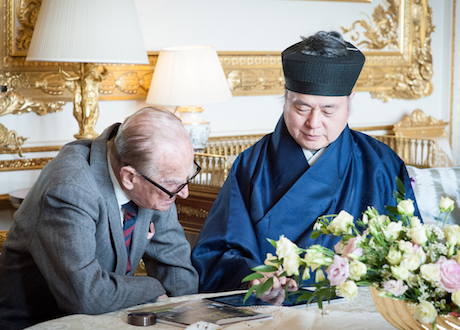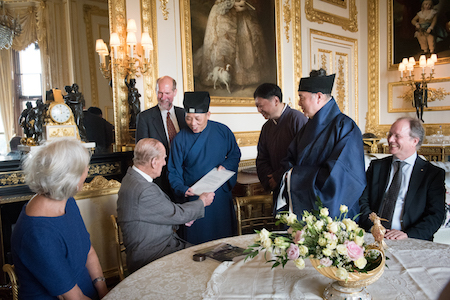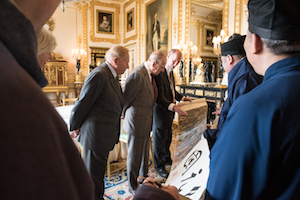| |
|
 |
How three Daoist Masters went to Windsor to meet the Prince
May 4, 2017:
 |
 |
 |
HRH Prince Philip and Master Zhang Gaocheng PHOTO: ARCWORLD.ORG/Katia Marsh |
His Royal Highness Prince Philip, the Duke of Edinburgh, today announced his retirement from his official duties. For more than 30 years, as the founder of ARC, he has been supporting our work and the work of many religions around the world in protecting the environment. The Duke, who will be 96 next month, will retire formally in the autumn.
His most recent official engagement to support ARC was two weeks ago, at Windsor Castle near London, with three Daoist Masters coming from China to talk about the environmental challenges, and how they are. Here is the story behind that meeting.
See our creative commons photos from the visit
“19th April, 2017. The Duke of Edinburgh this afternoon received a Daoist delegation from the Alliance of Religions and Conservation at Windsor Castle” Court Circular.
In 1985 the Duke of Edinburgh had an idea. If endangered animals were ever going to be successfully protected it was critical that local people believed it was important.
That year he asked a young British theologian and conservationist Martin Palmer to go and find out what other faiths believed about our human role in nature, and what they were doing about it.
 |
 |
 |
PHOTO: ARCWORLD.ORG/Katia Marsh |
The simple process of asking the two questions – treated with skepticism by some secular conservationists and some faith leaders, but welcomed by many others – had the extraordinary effect in so many communities of awakening something that had been dormant: the knowledge that we have a connection to the natural world, the knowledge that we now need to act on that.
In 1986, with WWF which was celebrating its 25th anniversary, it led to leaders from five main religions (Buddhism, Christianity, Hinduism, Islam and Judaism) coming together in Assisi and rather than making shared statements of what they have in common, making their own statements about what their faith teaches about how we treat nature.
And 10 years later it led to the formation of a charity, the Alliance of Religions and Conservation (ARC), whose main purpose was to keep asking those two questions, and then help leaders from 12 major world faiths work with secular conservationists to turn the answers into actions and projects and statements and plans.
In 1995 the Daoists joined in. That year the China Taoist Association joined ARC at its launch at Windsor Castle and Daoism became the ninth world religion to officially produce a theological statement on the environment.
Less than 20 years later, partly as a result of China’s rapid economic progress over the past three decades which has led to a great deal of money and a great deal of pollution, the Daoists are one of the main world religions to be taking ecological leadership seriously.
Daoism is China’s indigenous religion. It is named after the word dao, meaning path.Its followers believe the universe is guided by an impartial cosmic principle of order, and that to be healthy and wise and contented we need to keep everything in balance.
 |
 |
 |
PHOTO: ARCWORLD.ORG/Katia Marsh |
The world’s earliest recorded natural areas protected by the faiths were Daoist. They took the form of 36 Dongtian (translated as “Cave Heavens” but many of them are as big as mountains, not as small as caves) established in around the second century AD. They are protected places with many animals and plants, and with such a special atmosphere that many people believe the curtain between earth and heaven is very thin there.
During the Cultural Revolution in China in the 1960s and 1970s many of the 10,000 or more Daoist temples were destroyed, and many Daoist monks and nuns were forced to give up their robes and their religious vocation.
Now many temples are being rebuilt, and (thanks to the Duke’s question, the ongoing work of ARC, and the contributions of many sponsors including the World Bank, WWF and the Netherlands-based Valley Foundation) there are strict guidelines about how the rebuilding has to be sustainable in terms of materials, recycling, energy use, training, and relationship with local biodiversity.
The three Daoists meeting the Duke in Windsor Castle’s historic White Drawing Room last week were Master Zhang Fenglin (the first Secretary General of the China Taoist Association to be a Daoist monk rather than a bureaucrat); Master Zhang Gaocheng (Vice President of the China Taoist Association, in charge of the restoration of Tongbai Gong on Tian Tai Mountain, a temple destroyed in the 1950s when a reservoir was built) and his most senior follower Master Xie Sishang, also from Tian Tai mountain.
The last two had studied in the USA before choosing to become Daoist monks and they speak fluent English.
They were there to thank His Royal Highness for his help and friendship over the years, and to formally accept a letter of support from him for the fourth International Daoist Forum taking place on Wudang Mountain in May (which for the first time will have a large section of the programme dedicated to ecology).
They also wanted to report to him about the progress of finding new protections for the DongTian, which still have many rare species living within their bounds, of the Daoist announcements against using animal parts in medicine, using ivory in any situation at all, and excitingly of their plans to build a Daoist Ecological city, with solar energy, clean skies and minimum impact on the environment.
“How big will the city be?” the Duke asked,
“Oh, very small,” Master Zhang Gaocheng answered. “Only about 300,000 people.”
The importance of being kind to the Earth also extends to every Daoist temple in China, and again a lot of the initial credit for making this connection can be traced back to Prince Philip’s idea in 1985 of linking religions with conservation.
“We have issued ecological guidelines to more than a thousand temples now,” Zhang Fenglin told the Duke.
“The list includes water treatment, building to traditional styles, using solar power, actively replanting trees onto clearcut mountains. We are also seeing people bring huge amounts of offerings so the air is polluted… sometimes they fill plastic bags, and sometimes they fill the backs of the car with incense…. so we have suggested that people use just three incense sticks, and we have already noticed a difference” he said.
“Many tens of millions people go to the mountains and visit these temples every year,” Zhang Fenglin continued. We want to reach people, and teach them about protecting nature, while they are on holiday.
Traditional Chinese Medicine is one of the main reasons that there is a demand for rhino horn, tiger parts, bear gall, and other ingredients which involve excessive cruelty as well as killing rare and vulnerable animals.
“Traditional Chinese Medicine came from Daoism, and we want people to know that animal parts do not work. Using rare animals unbalances the whole of nature, so if you try and use it to heal your body, then it will unbalance you too and will be dangerous,” Master Xie said.
“In fact, even herbs are not always so effective. The best kind of medicine comes from the energy centres of the body through acupuncture, and from addressing your own inner thoughts and attitude.”
“This environment crisis is a crisis of the mind,” said Master Zhang Gaocheng “And to solve it we need to look inwards as well as outwards.”
“Prince Philip recognized in 1995 that Daoism not only had a message for China, but a unique message for the rest of the world,” Martin Palmer, secretary-general of ARC, said after the meeting.
“Daoists have yet to realise how important they are for the world.”
LINKSOur interview with HRH
The original Assisi declarations are learned at GCSE
Memories of Assisi 1985 by a young member of the Indian delegation
Our interview with HRH
On the amazing 2009 meeting of religions at Windsor
|
 |
 |
|
|
|
|
|

